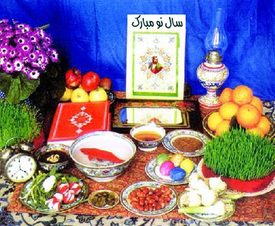Persian New Year, or Nowruz dates back over a thousand years and is a family event to celebrate the coming of spring. The two-week holiday begins the instant the sun crosses the celestial equator. This year it begins at 4:07 and 26 seconds PM-PST.
Norouz means "new day" in Farsi, the language of Iran, which is present day Persia. It begins on the first day of spring and is a two-week celebration of rebirth and renewal. Dating to pre-Islamic times, when much of the vast Persian Empire followed the religion of Zoroastrianism, Norouz today is the biggest holiday of the year in Iran. Schools and businesses are closed, and the well-to-do take vacations or retreat to the countryside.
Foods served during Norouz communicate spring themes. Sweet and sour flavors are meant to represent the duality of good and evil. Eggs represent fertility, and are served in dishes like the popular kuku (somewhat similar to an Italian frittata). Ash reshfte a warm noodle soup, typically begins the new year meal. The symbolism of the noodles it is said represent wishes for the unraveling of life's knotty problems. The main course for a typical Iranian New Year's meal is sabzi polo hami, or green herbs and rice, served with a white fish sauteed with chopped onion, lemon juice, turmeric, salt and fresh garlic.
The number seven has been sacred in Iran for thousands of years. Significance of number seven historically was to represent the "Seven Eternal Laws", which embodied the teachings of Zarathushtra. The teachings included having a good mind, good guidance, and discovering the ultimate truth among other things. At this time Iranians prepare a table or sofreh (a plastic sheet used as a tablecloth on the ground) on a rug with a variety of foods. Traditionally, these seven symbolic items are displayed for haft sin, the ceremonial table set for the Persian New Year. Sofreh-ye haft-sinn or "seven dishes' setting," each standing for the seven angelic heralds of life: rebirth; health; happiness; prosperity; joy, patience, and beauty. The holiday dishes -- each of which starts with the Persian letter sinn -- represent the keys to a happy life. The symbolic dishes consist of sabzeh, or sprouts, usually wheat or lentil, representing rebirth. Samanu is a pudding in which common wheat sprouts are transformed and given new life as a sweet, creamy pudding, and represents the ultimate sophistication of Persian cooking. Sib means apple and represents health and beauty. Senjed, the sweet, dry fruit of the wild olive, represents love. It has been said that when the wild olive is in full bloom, its fragrance and its fruit make people fall in love and become oblivious to all else. Seer, which is garlic in Persian, represents medicine. Somaq, sumac berries, represent the color of sunrise; with the appearance of the sun Good conquers Evil. Serkeh , or vinegar, represents age and patience. In addition seven sweets are often included:
"On the same table many people place seven special sweets because, according to a three-thousand-year-old legend, King Jamshid discovered sugar on Nowruz (the word candy comes from the Persian word for sugar, qand). These seven sweets are noghls (sugar-coated almonds); Persian baklava, a sweet, flaky pastry filled with chopped almonds and pistachios soaked in honey-flavored rose water; nan-e berenji (rice cookies), made of rice flour flavored with cardamom and garnished with poppy seeds; nan-e badami (almond cookies), made of almond flour flavored with cardamom and rose water; nan-e nokhodchi (chick-pea cookies), made of chick-pea flour flavored with cardamom and garnished with pistachios; sohan asali (honey almonds), cooked with honey and saffron and garnished with pistachios; and nan-e gerdui (walnut cookies), made of walnut flour flavored with cardamom and garnished with pistachio slivers."
~~excerpted from New Food of Life, Najimieh Batmanglij
A traditional menu includes ash-e reshteh, a hearty noodle soup; sabzi polow ba mahi, fresh herb rice and fish; and kuku ye sabzi, a lighter-than-air herb souffle. As with everything at Nowruz, many foods have meaning as an example: eating the noodles symbolically representing the Gordian knot of unraveling life's knotty problems. Before we wander too deeply into the vast waters of Iranian food culture this needs to work itself back to desserts in the Persian new year with this recipe for the traditional walnut flour cookie enjoyed at this time.
Nan-e gerdui
Walnut Cookies with cardamom, topped with pistachios
1 1/2 cups finely ground walnuts
3 egg yolks
3/4 cup white sugar
1 tablespoon ground cardamom
1 teaspoon baking soda
1 tablespoon rose water
1 egg yolk
1 teaspoon water
1/2 cup pistachio pieces for decoration
DIRECTIONS
Preheat the oven to 350 degrees F. In a medium bowl, mix together the ground walnuts, 3 egg yolks, sugar, cardamom, baking soda and rose water until well blended. Roll teaspoon sized pieces of dough into balls and place onto parchment-lined baking sheets. Cookies should be spaced 2 inches apart. Whisk together the remaining egg yolk and water using a fork. Press a walnut piece into each cookie, then brush with the egg yolk glaze.
Bake for 20 minutes in the preheated oven, or until golden. Although the cookies will look soft and under baked, they will harden considerably when cooled. Allow them to cool on the baking sheets for at least 10 minutes before transferring to a wire rack to cool completely.



Referenced here - http://www.chow.com/grinder/2436
Posted by: | March 24, 2007 at 01:23 PM
What a lovely and interesting piece on another food culture. Thanks for sharing it!
Posted by: bea at La tartine gourmande | April 01, 2007 at 05:17 PM
Thank you for this informative post. I look forward to trying these cookies.
I am also looking for a good recipe for nan-e nokhodchi (roasted chickpea flour cookie) and wondered if you had come across one? If so could you please contact me on my blog. Many thanks.
Erika
Posted by: Erika at Sweet Pea | January 20, 2009 at 01:48 AM